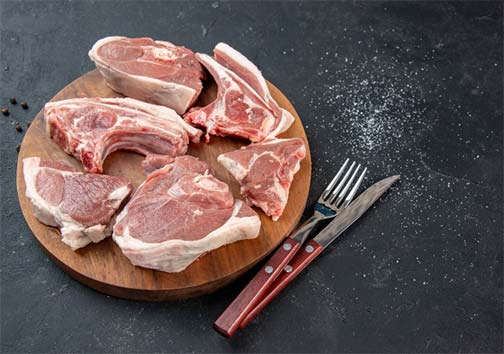 Import News
Import News
 12-09-2024
12-09-2024
Imports of frozen pork cut remain a significant aspect of global trade, with several countries relying on these imports to meet domestic demand. In 2023, five key markets emerged as top importers, each driven by specific factors such as population growth, rising incomes, and shifts in industry and trade patterns. Below is a look from Tendata at the leading countries that import frozen pork cut in 2023 and the dynamics shaping their demand.

1. China: The Largest Importer of Frozen Pork Cut
China solidified its position as the world’s largest market for imports of frozen pork cut, with an import value of 756.7 million USD in 2023. China's soaring demand for pork is largely attributed to its growing population and increasing income levels, which have spurred a rise in meat consumption. Pork, in particular, plays a central role in the Chinese diet, and domestic production struggles to keep pace with demand. As a result, China sources frozen pork cut from a variety of global suppliers, including the United States, the European Union, and Brazil.
2. Dominican Republic: A Growing Market
The Dominican Republic ranks as the second-largest country for imports of frozen pork cut, with an import value of 196.3 million USD in 2023. The country has seen a notable increase in demand for frozen pork products, driven by the rapid expansion of its tourism industry and rising income levels among its population. Tourism has played a particularly important role, as hotels, restaurants, and resorts require a steady supply of high-quality pork products. The Dominican Republic primarily imports frozen pork cut from the United States and Canada, leveraging trade agreements and geographic proximity.
3. The Philippines: Steady Growth in Demand
The Philippines also features prominently among the top markets that import frozen pork cut, with imports valued at 36.4 million USD in 2023. As the country’s urban population grows and urbanization continues, demand for pork products has risen steadily. In particular, frozen pork cut is a popular choice for both household consumption and the restaurant industry. The Philippines sources its pork mainly from the United States, Canada, and Australia, reflecting its reliance on international suppliers to satisfy domestic consumption needs.
4. Italy: A Culinary Powerhouse with High Demand
Italy imported frozen pork cut worth 32.8 million USD in 2023. Italy’s high meat consumption, driven by its strong culinary traditions, makes pork a staple in the Italian diet. Pork is essential for the production of various traditional Italian dishes, including cured meats like prosciutto and salami. Italy primarily imports frozen pork cut from European suppliers, with Germany, Denmark, and the Netherlands being the leading exporters. The close proximity of these countries allows for efficient trade within the European Union.
5. Netherlands: A Hub for Global Trade
The Netherlands, with an import value of 32.0 million USD, is a major importer of frozen pork cut. The country’s demand has been bolstered by its role as a hub for international trade and logistics. The Netherlands imports frozen pork cut from Germany, Spain, and Belgium, leveraging its well-developed transportation and port infrastructure to distribute pork products throughout Europe and beyond. Despite being a significant exporter of pork, the Netherlands imports frozen pork cut to meet the needs of its processing industry and re-export demands.
Conclusion
In 2023, the global market for frozen pork cut was dominated by these five countries, each with unique factors driving their imports of frozen pork cut. China remains the largest importer, reflecting its vast population and increasing meat consumption. Meanwhile, the Dominican Republic and the Philippines are experiencing steady growth in imports due to economic expansion and urbanization. Italy and the Netherlands, with their strong culinary traditions and central roles in global trade, also continue to be major importers of frozen pork cut. Together, these markets highlight the diverse and dynamic nature of global pork trade.
1. Establishing a Customer Database by Country:
Building a customer database is akin to maintaining a work record. Start by using trade tracking features to compile a list of all customers in a country. Analyze each buyer's purchase volume, procurement cycle, product specifications, and supplier system. Finally, filter out 30% of the potential high-quality customers from this country and record them in your customer database, allowing flexible settings by country, time, customer name, follow-up steps, contact phone, email, contact person, etc. (>>> Click For Free Customer Development)
2. Establishing a Customer Database by Peer Companies:
Have a clear understanding of the names of peer companies (including full names, abbreviations, etc.). Use the global supplier network feature to gather all customers of these peers in the system. Analyze these customers based on purchase volume, procurement cycle, and product models. Finally, filter out key customers from your targeted peers and record them in your customer database. (>>> Click For Free Trial Application)
3. Identifying Newly Appeared Customers in Each Country:
Utilize the trade search function to select a country, set date ranges, limit product names or customs codes, and check "latest." The search results will display high-quality customers that have recently appeared in that country during the specified time period. Since these customers are newly emerging, they may have unstable supplier relationships, requiring focused follow-up. Record these new potential buyers in your customer database. (>>> Click For Free Demo Application)

These three approaches for customer development using customs data can be implemented based on the actual needs of the company. Considering market conditions, industry characteristics, strategic requirements, etc., find a method that suits your preferences. The ultimate goal is to establish and organize a categorized archive of high-quality customers. Once suitable customers are identified, the next step is to make precise contact through various channels such as phone calls, email communication, online chat, etc.
Category
Leave Message for Demo Request or Questions


 T-info
T-info T-discovery
T-discovery

 My
Tendata
My
Tendata Market Analysis
Market Analysis Customer
Development
Customer
Development Competitor
Monitoring
Competitor
Monitoring Customer Relationship
Customer Relationship





































































































































